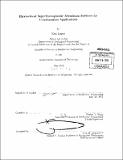Hierarchical superhydrophobic aluminum surfaces for condensation applications
Author(s)
Lopez, Ken, S.B. Massachusetts Institute of Technology
DownloadFull printable version (5.026Mb)
Other Contributors
Massachusetts Institute of Technology. Dept. of Mechanical Engineering.
Advisor
Evelyn N. Wang.
Terms of use
Metadata
Show full item recordAbstract
Many existing industrial systems, including thermal desalination plants and air conditioning systems, involve the process of condensation and are heavily dependent on this process for achieving adequate levels of energy efficiency. In order to obtain these levels of efficiency, condensation heat transfer must be optimized through the application of dropwise condensation. One ongoing solution for improving the performance of dropwise condensation is the implementation of superhydrophobic structures and chemistries on condensing surfaces. Aluminum, being a heavily utilized material in many condensing systems and other industrial applications, is the subject of the present study. This thesis presents methods for synthesizing aluminum surfaces to produce microstructured morphologies through chemical etching with hydrogen chloride and oxidation with sodium hydroxide. After functionalization of these surfaces with a hydrophobic surface coating, the surfaces were tested for condensation using optical microscopy and a high quality environmental chamber. From experimentation, condensed droplets on these surfaces were unable to achieve the proper Wenzel to Cassie-Baxter transition and produce a jumping behavior which is a necessary criterion for superhydrophobic condensation. However, the HCl etched aluminum surface was able to achieve heat transfer rates greater than the smooth, filmwise aluminum surface by a factor of 2 and greater than the smooth, dropwise aluminum surface by a factor of 5/3. This implies that these structures were still capable of improving heat transfer rates despite their inability to surpass the energy barrier required for superhydrophobic condensation.
Description
Thesis (S.B.)--Massachusetts Institute of Technology, Dept. of Mechanical Engineering, 2012. Cataloged from PDF version of thesis. Includes bibliographical references (p. 51).
Date issued
2012Department
Massachusetts Institute of Technology. Department of Mechanical EngineeringPublisher
Massachusetts Institute of Technology
Keywords
Mechanical Engineering.